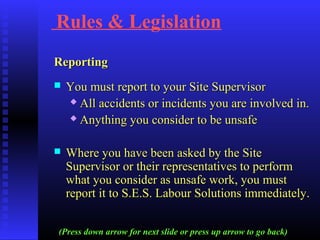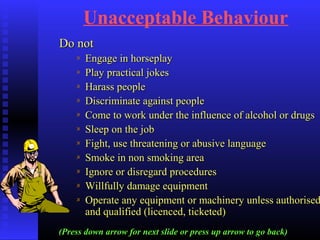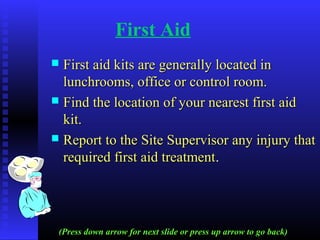Ses safety induction
- 1. Welcome To S.E.S. Labour Solutions Safety Induction
- 3. Introduction •This induction is a general safety induction to help you work safely. •The induction requires you to read and understand this presentation. • At the end of this presentation there is a short assessment that you are required to complete •Completing this induction and successfully completing the assessment is a condition of your employment
- 4. Rules & Legislation •You have an obligation (responsibility) under the WHS Act 2011 QLD to take all reasonable steps to prevent accidents. •You must –Comply with instructions –Use personal protective equipment (PPE) •You must not –Willfully or recklessly interfere with or misuse anything in the workplace –Willfully place other people at risk –Willfully injure yourself
- 5. Rules & Legislation ReportingReporting You must report to your Site SupervisorYou must report to your Site Supervisor All accidents or incidents you are involved in.All accidents or incidents you are involved in. Anything you consider to be unsafeAnything you consider to be unsafe Where you have been asked by the SiteWhere you have been asked by the Site Supervisor or their representatives to performSupervisor or their representatives to perform what you consider as unsafe work, you mustwhat you consider as unsafe work, you must report it to S.E.S. Labour Solutions immediately.report it to S.E.S. Labour Solutions immediately. (Press down arrow for next slide or press up arrow to go back)
- 6. Fit for Work Rules and regulations require that you are in aRules and regulations require that you are in a fit condition for workfit condition for work You must ensure that you areYou must ensure that you are Physically and physiologically fit for dutyPhysically and physiologically fit for duty You are not impaired from alcohol or drugsYou are not impaired from alcohol or drugs You must not take onto site any alcohol or drugsYou must not take onto site any alcohol or drugs You must not consume any alcohol or drugs onYou must not consume any alcohol or drugs on sitesite You will undergo a drug and alcohol test ifYou will undergo a drug and alcohol test if involved in a major accident.involved in a major accident. (Press down arrow for next slide or press up arrow to go back)
- 7. Unacceptable Behaviour Do notDo not Engage in horseplayEngage in horseplay Play practical jokesPlay practical jokes Harass peopleHarass people Discriminate against peopleDiscriminate against people Come to work under the influence of alcohol or drugsCome to work under the influence of alcohol or drugs Sleep on the jobSleep on the job Fight, use threatening or abusive languageFight, use threatening or abusive language Smoke in non smoking areaSmoke in non smoking area Ignore or disregard proceduresIgnore or disregard procedures Willfully damage equipmentWillfully damage equipment Operate any equipment or machinery unless authorisedOperate any equipment or machinery unless authorised and qualified (licenced, ticketed)and qualified (licenced, ticketed) (Press down arrow for next slide or press up arrow to go back)
- 8. General Safety Safety SignsSafety Signs Safety signs draw your attention to safetySafety signs draw your attention to safety situation and objects.situation and objects. Safety signs must be complied with andSafety signs must be complied with and have the same authority as a supervisor’shave the same authority as a supervisor’s instructioninstruction Do not damage, destroy or remove safetyDo not damage, destroy or remove safety signssigns (Press down arrow for next slide or press up arrow to go back)
- 9. Road Traffic Signs Same meaning as on roadsSame meaning as on roads Controls trafficControls traffic (Press down arrow for next slide or press up arrow to go back)
- 10. Mandatory Signs Signs are blue and whiteSigns are blue and white in colourin colour.. Pictured instructionsPictured instructions mustmust be carried out.be carried out. (Press down arrow for next slide or press up arrow to go back)
- 11. Prohibitory Signs Red, black and white with the red circle andRed, black and white with the red circle and red diagonal.red diagonal. Pictured action or activity is not permitted.Pictured action or activity is not permitted. (Press down arrow for next slide or press up arrow to go back)
- 12. Warning Signs Black and yellowBlack and yellow Hazard or hazardous condition.Hazard or hazardous condition. Not life threatening but use caution.Not life threatening but use caution. (Press down arrow for next slide or press up arrow to go back)
- 13. Danger Signs Red, black and whiteRed, black and white Hazard or hazardous conditionHazard or hazardous condition Life threatening - Do not proceed unlessLife threatening - Do not proceed unless authorised.authorised. (Press down arrow for next slide or press up arrow to go back)
- 14. Emergency Information Signs Green and white.Green and white. Location or direction to emergency relatedLocation or direction to emergency related facilities. eg first aid kits or exits.facilities. eg first aid kits or exits. (Press down arrow for next slide or press up arrow to go back)
- 15. Fire Related Signs Red and white.Red and white. Location of fire fighting equipment.Location of fire fighting equipment. (Press down arrow for next slide or press up arrow to go back)
- 16. Personal Protective Equipment (PPE) PPE must be worn at all time when:-PPE must be worn at all time when:- Instructed by a procedureInstructed by a procedure Safety signs displayedSafety signs displayed Instructed by a supervisorInstructed by a supervisor You think added safety protection isYou think added safety protection is required.required. (Press down arrow for next slide or press up arrow to go back)
- 17. PPE PPE you must wear includes:-PPE you must wear includes:- Safety boots (steel toe capped boots)Safety boots (steel toe capped boots) Safety helmet (hard hat)Safety helmet (hard hat) Eye protection (safety glasses, face shields,Eye protection (safety glasses, face shields, goggles)goggles) GlovesGloves Hearing protection (ear plugs, ear muffs)Hearing protection (ear plugs, ear muffs) Respirators (disposable masks, cartridgeRespirators (disposable masks, cartridge respirators)respirators) Sun protection (hat, clothing, sun screen)Sun protection (hat, clothing, sun screen) Protective clothing (long sleeved shirt, longProtective clothing (long sleeved shirt, long trousers)trousers) (Press down arrow for next slide or press up arrow to go back)
- 18. PPE PPE should be :- • Suited for the intended task • Inspected prior to use • Fitted properly • Hygienic
- 19. Workplace Hazards A hazard is a thing or situation with the potentialA hazard is a thing or situation with the potential to cause injury or illness to a person.to cause injury or illness to a person. You are required to continually identify andYou are required to continually identify and control hazards in the workplace.control hazards in the workplace. You should conduct informal risk assessments byYou should conduct informal risk assessments by askingasking What am I about to do?What am I about to do? What can go wrong?What can go wrong? What can I do to stop it going wrong?What can I do to stop it going wrong? (Press down arrow for next slide or press up arrow to go back)
- 20. Workplace Hazards Some typical workplace hazards are:- –Manual handling – lifting –Using ladders –Working at heights and falling objects –Working with electricity –Working with compressed air –Working with chemicals and hazardous substances –Vehicles and mobile equipment –Rotating machinery
- 21. Manual Handling - Lifting Take care of your back. About 25% of all workTake care of your back. About 25% of all work injuries are back injuriesinjuries are back injuries When lifting:-When lifting:- Use straight backUse straight back Lift with your legsLift with your legs Feet apart for good balanceFeet apart for good balance Use firm gripUse firm grip Use mechanical lifting equipmentUse mechanical lifting equipment Get help to move the loadGet help to move the load (Press down arrow for next slide or press up arrow to go back)
- 22. Working at Heights and Falling Objects If 2.4 M above the ground and outsideIf 2.4 M above the ground and outside handrails, wear a safety harness (fall arresthandrails, wear a safety harness (fall arrest equipment)equipment) When working at heights, make sure theWhen working at heights, make sure the area beneath you is barricaded againstarea beneath you is barricaded against people getting hit by falling objects such aspeople getting hit by falling objects such as dropped tools.dropped tools. (Press down arrow for next slide or press up arrow to go back)
- 23. Working with Electricity •Inspect leads and electrical equipment for damage and defects before use •Check electrical inspection tags •Use earth leakage protection devices (electrical safety switches) •Never operate electrical equipment while standing in water •Treat extension leads carefully •Look out for overhead power lines •Do not use double adaptors
- 24. Compressed Air Safety Do not blow yourself down (clean clothes)Do not blow yourself down (clean clothes) using compressed airusing compressed air Do not crimp air hosesDo not crimp air hoses Use safety clips at hose connectionsUse safety clips at hose connections Do not allow compressed air to contact skinDo not allow compressed air to contact skin – air embolism results in death.– air embolism results in death. (Press down arrow for next slide or press up arrow to go back)
- 25. Chemicals and Hazardous Substances Many workplace deaths, accidents and injuriesMany workplace deaths, accidents and injuries result from chemicalsresult from chemicals Chemicals must be used, handled and stored inChemicals must be used, handled and stored in accordance with Material Safety Data Sheetsaccordance with Material Safety Data Sheets (MSDS)(MSDS) MSDS describe the safety precautions to beMSDS describe the safety precautions to be followed for that chemicalfollowed for that chemical (Press down arrow for next slide or press up arrow to go back)
- 26. Vehicles and Mobile Equipment Make sure you are authorised to drive on siteMake sure you are authorised to drive on site Follow the site road rulesFollow the site road rules Watch out for pedestriansWatch out for pedestrians Park in designated car parksPark in designated car parks Wear the seat beltWear the seat belt Only ride in the provided seatingOnly ride in the provided seating Operate equipment (and drive vehicles) in a safeOperate equipment (and drive vehicles) in a safe mannermanner (Press down arrow for next slide or press up arrow to go back)
- 27. Rotating Machinery •Keep hands and clothing away from machinery nip points (pinch points) •Ensure machine guards are in place and well maintained •Never remove a guard to work on a moving machine •Ensure machinery has fully stopped before commencing working on the machine (some machinery takes several minutes to coast to a stop)
- 28. Fire •Check for the location of the nearest fire extinguisher (first activity in a new work area) •Find the location of the button (switch, etc) for the fire alarm •Find the location of the nearest fire assembly point (muster point) •Prevent fires by –Maintain high standards of housekeeping –Do not smoke around flammable materials –Take precautions when conduct welding or oxy work around flammable materials
- 29. First Aid First aid kits are generally located inFirst aid kits are generally located in lunchrooms, office or control room.lunchrooms, office or control room. Find the location of your nearest first aidFind the location of your nearest first aid kit.kit. Report to the Site Supervisor any injury thatReport to the Site Supervisor any injury that required first aid treatmentrequired first aid treatment.. (Press down arrow for next slide or press up arrow to go back)
- 30. Lock out/Tag out - Isolation Danger tags and locks are used to protect youDanger tags and locks are used to protect you from machinery being started up by someonefrom machinery being started up by someone else while you are working on itelse while you are working on it Always use danger tags and locksAlways use danger tags and locks When even you see a tag, you should read itWhen even you see a tag, you should read it Only you can remove your danger tagsOnly you can remove your danger tags Do not remove other people’s danger tagsDo not remove other people’s danger tags Ensure the correct switch is isolatedEnsure the correct switch is isolated Test by trying to restart to ensure correctTest by trying to restart to ensure correct isolationisolation
- 31. Out of Service Tags Out of service tags are use to protectOut of service tags are use to protect machinery that should not be used ormachinery that should not be used or that could be a hazard if used.that could be a hazard if used. Out of service tags should be placed onOut of service tags should be placed on the main isolating switchthe main isolating switch Out of service tags can be removed byOut of service tags can be removed by the person who completes the repairs orthe person who completes the repairs or an authorised person.an authorised person. (Press down arrow for next slide or press up arrow to go back)
- 32. Finish This is the end of the induction presentationThis is the end of the induction presentation Please complete the provided writtenPlease complete the provided written assessmentassessment Please do not hesitate to ask for help if youPlease do not hesitate to ask for help if you have any questions, concerns or havinghave any questions, concerns or having difficulties.difficulties. (Press up arrow to go back)
Editor's Notes
- AJAX































